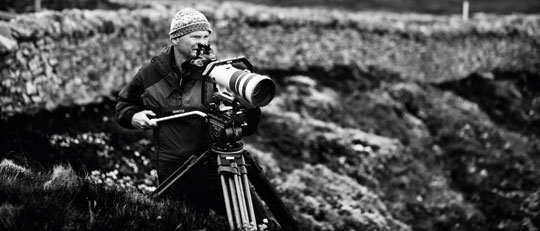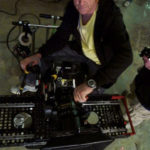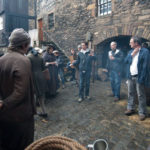
Kit Building with Canon Video DSLRs
Posted on Oct 19, 2010 by Alex Fice
Simon King with a SHAPE rig and Canon 5D Mk2 Pic credit Brydon Thomason
Born of a personal love affair with the Shetland isles, last spring, Simon King produced a wonderful three part series ‘Simon Kings Shetland Diaries’ which saw him live in the Shetland isles with his family for over a year observing and filming the wildlife, ever changing seasons and daily existence of the islanders. Following its success Simon was asked if he would consider becoming an ambassador for the Shetland Isles and appearing in a commercial for promote Shetland.org. Given his affection for the place he didn’t have to think about it for long, given his profession he also threw into the mix the option for him to make the commercial having first hand knowledge of the islands, the people that had so warmly welcomed him and the abundant wildlife.
Off the back of this request Simon called in long term friend and colleague John Maguire to work along side him photographing and producing the commercial footage.
First conversation between King and Maguire was: what to shoot on? Having previously worked together on Tokki’s Tale in Kenya shooting actuality on HDV and wildlife on Super 16mm, this way of working felt almost passé given the recent explosion of HD possibilities. “We were also very keen to produce the highest quality digital images (within budget) for Promote Shetland so in the future they could be released across all media from web to large screen”.
For personal reasons Maguire had stepped out of production for a few years and when called upon by King was just re-engaging with the vast changes that had taken place during that time. “Five years ago we shot the ‘Geldof in Africa’ series on seventy thousand pounds worth of equipment in the form of Panasonic’s Varicam, the results were stunning at 720P but here we are now, a few years later, looking at equally amazing images for a fraction of the cost, produced full 1080 from a Canon 5D Mk2 …the advances in technology are crazy …and very exciting” says Maguire
“The Canon 5D seems to be revolutionising the moving image camera market. Canons are going from strength to strength with their development of DSLR technology and features; the fact that it shoots true HD has taken the market by storm. Superb HD Video combined with stills lenses that are arguably sharper and faster than production video lenses, the 5D is bringing photography back into video.
“I won’t wax on too much about the Canon 5D Mk 2 with it’s full sized CMOS sensor …there are a wealth of detailed reviews on the web, most of which a true ‘tech fest’ and most agree on the efficacy and virtues of the camera. What I would like to mention is the Canon 7D.”
 Simon King with Canon EOS 7D. Pic credit Josh Fry
Simon King with Canon EOS 7D. Pic credit Josh Fry
The Canon 7D 18 megapixel, APS-C sensor has a 1.6x crop factor on lenses. That means it can be frustrating for wide angles, but a real boon with telephoto, effectively increasing the power of your lens by a factor of 1.6x. So, for example, a 500mm has the effect of an 800mm in terms of magnification. Full HD (1920×1080) movies at 25 fps (or 24 /30 if you have a use for that!) and 1280×720 when shooting at 50fps (PAL!) means you get super high quality video images and a true slow motion capacity. “For sure, the slo-mo is not going to compete with super slo-mo cameras as used so often these days in commercials and Natural History productions, but then, the camera doesn’t cost £100k either! It DOES do much the same thing as certain video cameras that cost in the region of £40k!”
So the cameras were agreed upon – 5D MK2 for wide angle and general photography, landscapes etc. Canon 7D for long lens telephoto photography.
“We used two lens kits: predominantly our own Canons: 500mm f4, 100-400mm f4, 28-300mm f4, 28-70mm f2.8 and a newly purchased 17-40mm f4 to fully exploit the landscape possibilities and width available from the full sized CMOS sensor on the 5D Mk2. We also took a set of Zeiss CP2 prime lenses to try out. These performed extremely well at low light and in particular in a musical evening barn setting lit to simulate a late evening sunset. The lenses were crisp with image definition that was first class. For the barn scene we used the 28mm, 50mm and 85mm, all T 2.1. They were all fast, super crisp and well engineered. The focus and aperture rings were very smooth. Canon Cameras and lenses were supplied through London Camera Exchange who Simon has a long history with. The advantage of buying from the likes of LCE is you are almost certain to be assisted by a staff member who will be able to talk with a deep knowledge of the product he’s selling. They will, more often than not, have also tried the equipment out in the field; this human interaction is to me important in ironing out the little glitches that often come with new pieces of kit.
“The peripheral Market surrounding the success of the Canon 5D is worth approximately $4 Billion in the USA alone so there are plenty of add-ons to make the Canon DSLR a fully operable film camera out in the field. Most of this lucrative economy probably stems from the prosumer markets but has anyone tried the available equipment in a professional location as rough and tumble as the world of Wildlife photography?
“First challenge was to choose a support rig for the camera. Immediately followed the inevitable trawl through the Internet, blogs and colleagues pointing towards Micro Rock and Zacuto. Maybe it’s me but nothing I looked at seemed to be suited to our application or configured for work out in an environment like the natural history environment
 Simon King and john Maguire with both Canon EOS DSLRs. Pic Credit Josh Fry
Simon King and john Maguire with both Canon EOS DSLRs. Pic Credit Josh Fry
“We needed two rigs one to support a 5D Mk2 with a variety of lenses, predominantly wide to be used hand held or on a tripod, the other to support a Canon 500mm f4 with a 1.4 x converter. In addition to this we wanted to record a quality guide track to the camera and in addition to that broadcast quality and back up audio to a recorder, all this most likely in the howling wind and pouring rain while on a boat getting soaked! …Just because that’s when the Orcas would decide to show themselves!
“I found most web sites I looked at hard work, the principle of a modular system is great but piecing together the right configuration without the equipment in front of you can also be confusing in choice. I than had an ‘Eureka’ moment. I called Pro Kit a West London supplier of cameras and equipment I often used to supply equipment, tripods, filters, etc and just happened to mention his frustrations, ‘Why don’t you look at Shape’ replied a calm voice? ……Before the …pe had rolled of the sales assistants tongue I had Google on the case. …That’s it that’s what I’ve been looking for, a complete unit that will fit all applications. I was looking at the ‘Shape Composite Fiction’. www.shapewlb.com
Shape
Pro Kit had just, two days before, received their first demo of the Shape DSLR and Camcorder rigs, testimony to the expansion of the peripheral markets surrounding the DSLR in the UK. Shape WLB Inc is based in Quebec, Canada, an innovative and creative company who have been working on movie and television sets for over 15 years. They develop and manufacture custom-built equipment for video and photo cameras. ‘Built by cameramen for cameramen’ is their mantra.
“I went to the Pro Kit showroom and looked at the Shape rig, it turned out to be pretty much everything I needed. Solid, lightweight aluminium construction, no tools necessary and assembled in only three key sections: the base plate and circular handle (Paparazzi II Pro), The shoulder pad and the front quick handles. The circular handle is factory prepared with various threaded holes (1/4-20, 3/8-16) great for attaching microphones, a small monitor and a light panel. The shoulder mount comes with a back pad or an optional counter weight. The front handles are the patented QUICK HANDLE. Each handle can rotate individually on 360 degrees. Simply push and hold the button, located at the articulation, and rotate the handle. Once the button is released, the handle stays firmly in place and will not move at all.
“We worked with two rigs: the full Composite Fiction for hand held and tripod use, shooting predominantly wide angle photography, and the Paparazzi II pro as a cage for the Canon 500mm f4. I used an extra counter weight for hand held photography (my preference) and micro arms to mount a Rode Videomic (guide audio to camera) and a Rode NTG3 for master audio phantom powered by a Zoom H4n. The Zoom was easy to operate and I saw the advantages of having four tracks to record on. Unfortunately we had problems with batteries lasting as little as 30mins, a problem we couldn’t get to the bottom of the on location so we re-routed the NTG3 through a Beachtek DXA-SLR for phantom power.
“Simon used the Paparazzi II Pro for long lens photography. He had a Beachtek DXA-SLR and used an Olympus LS11 recorder for master audio, the Rode NTG3 microphone was attached via a Rode SM4. The only other notable piece of hardware was a Giottos MH631 quick release plate between the Paparazzi riser and the camera.
 Simon King with the SHAPE rig
Simon King with the SHAPE rig
“With the base counter weight 4lb (supplied) and additional 4lb counter weight (additional) the complete rig is quite heavy, certainly once you’ve got the camera, microphone, Matt box, and you’re using something like a Canon 28-300 f4. I’m happy with the weight but I’m not sure it would be to everyone’s liking. The weight gives extra stability, it’s also compensated by the support arm and waist belt supplied. I can comfortably follow action or choreograph a camera move shooting on a 300mm with a surprising amount of stability.
“The support arm and belt are also very useful in releasing your hands to operate shutter release, stop/start record button and adjusting exposure while at the same time adjusting focus or telephoto with the other hand. I think it’s important to note that traditionally TV production, actuality, documentary etc have used motorised zoom lenses with a degree of automatic functions both on the camera and lenses. This because the situation in front of camera is not as controlled as a film set or a drama and gathering the required variety of shots to cover a scene is necessary in a shorter amount of (usually uncontrolled) time.
“As someone who tends to use all his camera settings on manual, one arguably needs three hands to operate a DSLR as a movie camera, (four when chasing Orcas on a small boat!) this is where the support arm and belt are invaluable. I also mentioned earlier that I believe DSLRs have put the photography back in to video. What I mean by this is working with a DSLR you have to constantly be aware of the basic principles of photography: lens choice, f-stop, ISO, exposure depth of field etc. This in my opinion is good thing and something that has been taken away by the one stop ‘green’ auto settings of modern ‘anyone can shoot’ camcorders. If you have to think about your picture chances are it will be a good one.
“I was very pleased with the Shape rig as the backbone platform for my DSLR configuration. The philosophy of offering a comprehensive rig as a starting point to a modular idea made shopping much easier for me …and as a bloke that’s a good thing! I shoot with my left eye and the rig can be easily configured for either shoulder. The only negative point I could find is that a few of the bolt heads on the support arm have rusted up, this is a little disappointing on a such a well thought through piece of equipment.
 John Maguire with full rig
John Maguire with full rig
“For audio we also needed lightweight and robust equipment and decided that the small microphone on the Canon camera would not be suited to the majority of environments we would face. Good audio to accompany the astonishing high quality of the video image produced by the new generation of Canon DSLRs can be a problem. Some, like the 7D, do not have a manual gain level control and so will ‘hunt’ for audio when things get a little hushed. This can result in a rising background hiss on your audio track
The NTG3 is a precision broadcast-grade shotgun microphone. It is the result of years of development by RØDE engineers, an affordable yet uncompromising microphone for the broadcast film and television industry. We chose it because it is almost completely resistant to moisture, making it a preferred option when recording in the demanding environments we are used to and where condensation is an issue. It also ticked the light weight and portable box coming in at 163g.
“When not in use it was stored away in it’s weather resistant aluminium storage cylinder, providing additional protection from the Shetland Isles macro climates.
“Samsung are not the first name I would think of when looking for memory cards but we were lucky enough to come across them just before we went to the Shetland Isles. Armed with the knowledge that we would be traipsing across fields, shimmying down cliffs and buffeted along in a small boat the sales tag ‘shook proof and waterproof’ caught my eye. The cards look pretty much the same as most on the market, albeit far less garish, but the main difference for me is they seem heavier than others I’ve used which makes them feel sturdier. A little further investigation on the web revealed they are made of stainless steel and offered ‘sturdiness’ and ‘high performance, assuring premium quality’ …well who am I to argue with that? With a read speed of 45MB/S and write speed of 35MB/S they far surpass the min requirement of min 8MB/S read/write speed recommended by Canon for the 5DMk2 when shooting video.
“We opted for the Samsung and used the 8 GB 233x PLUS CF cards for our cameras (Canon 5D MK2 & 7D) and the smaller 8GB SD PLUS cards for master audio (recording onto an Olympus LS 11 stereo recorder via a Rode NTG3), they certainly stood up to their Shockproof and weatherproof tag. The one negative for me, and it’s a minor point, is the plastic case the CF cards are supplied in, it’s not as shockproof. Samsung should take their own lead on this point by supplying the CF cards with the same rubber sleeve provided for their range of SD Plus cards. But will I think of Samsung next time I need memory cards? Without question.”
Kit list and Supplier links below
Kit list
Shape Composite Fiction
Shape Paparazzi 2 Pro
Cameras: Canon
2x EOS 5D Mk2
EOS 7D
Canon lenses: 500mm f4, 100-400mm f4, 28-300mm f4, 28-70mm f2.8, 17-40mm f4
RC6 remote
Aqua Tech sports shield: SS200, SS300, SS600 (Cameras Underwater)
Hoodman Cinema Kit Pro
Giottos MH631 quick release plate
Genus Wide 4×4 Matte Box
4×4 Filters: .6 & .9 ND soft grads
4×4 Linear Polar
Samsung 8gb CF cards
Audio: Rode
NTG3 Microphone
Videomic
Blimp inc dead wombat
Dead cat wind protector
SM3 Mount
WS7 Windshield
Zoom H4n recorder
Olympus LS11 recorder
Radio Mic
BeachTek DXA-SLR
Redrock Micro arms
Various XLR and mini-jack leads
Cable ties & Velcro straps
Carbon fibre two stage legs
Ronford-Baker 2003 & 2004 fluid head
Links
http://www.genustech.tv/matte-boxes
http://www.camerasunderwater.co.uk
http://www.zoom.co.jp/english/products/h4n












